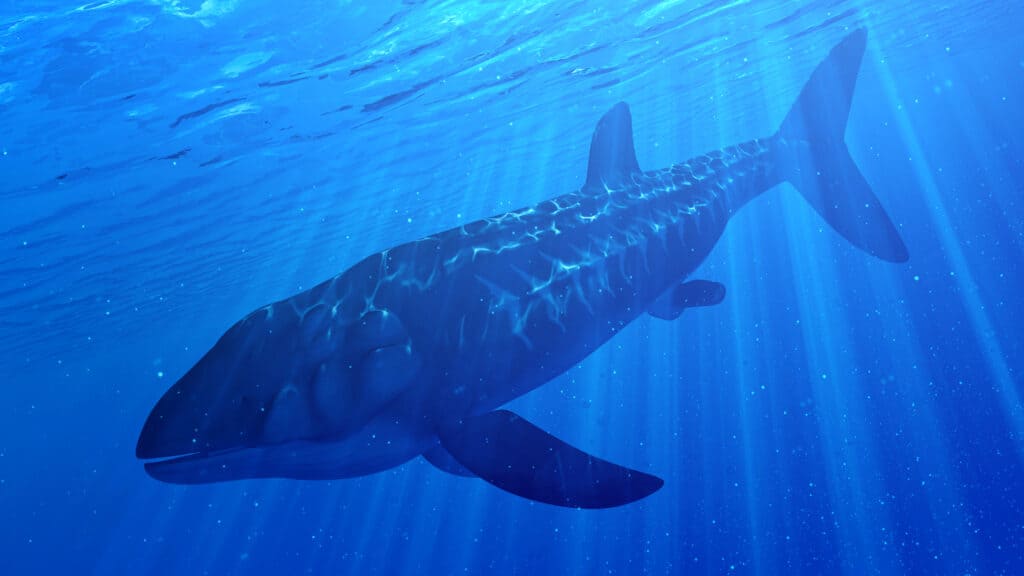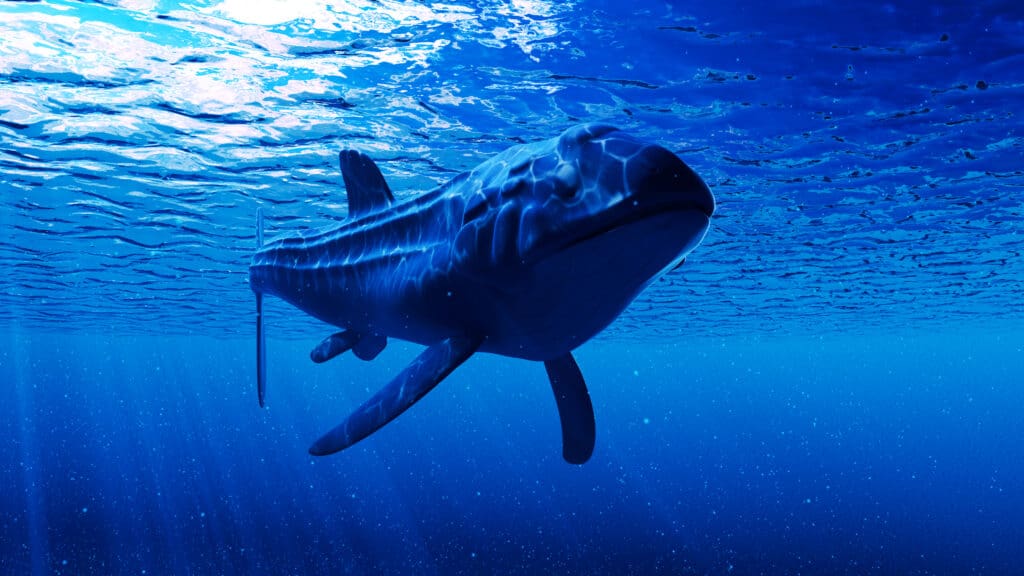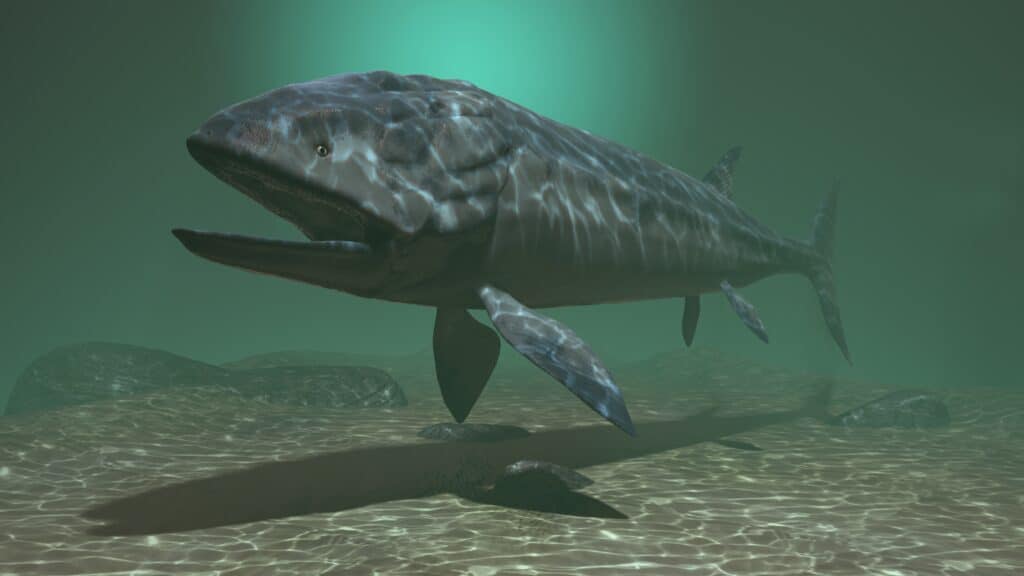The ocean has arguably held most of the world’s history and some of the most amazing creatures within its belly. One of the most talked-about creatures in the ocean is the shark. The great white shark, which is the most popular shark, is known for its aggressiveness, power, and size. These highly predatory sharks can grow up to 20 feet and have an average weight of over 2,000 pounds but can grow up to 5,000 pounds. However, there once was a fish species that was 22 times bigger than the great white shark, which is approximately about 100,000 pounds.
According to reports, this gigantic fish was even bigger than the whale shark, which is currently the largest fish worldwide. Outstanding, right? This article introduces you to the Leedsichthys problematicus, the massive fish that was 22 times bigger than a great white.
Meet Leedsichthys Problematicus

Leedsichthys lived in the middle to late Jurassic Period and fed on plankton.
©SciePro/Shutterstock.com
According to the Guinness World Records, Leedsichthys problematicus is the largest bony fish ever. These massive fish species existed about 165 million years ago in the Late Jurassic period. These aquatic giants weighed up to 45 tons, which is a behemoth size compared to modern aquatic animals. In terms of length, Leedsichthys problematicus was once thought to grow to 90 feet, but new research in 2013 placed their length closer to 55 feet.
Leedsichthys is an extinct genus of the family Pachycormidae, which roamed the ocean from the early Jurassic period to the Late Cretaceous period. This giant fish family was believed to be the ancestor of modern bony fish. In this present day, the closest bony fish to the Leedsichthys problematicus size is the sunfish. According to news reports, the largest bump-head sunfish in the world weighs about 6,000 pounds.
What Did Leedsichthys Problematicus Look Like?

The Leedsichthys had a relatively large and elongated head and 40,000 teeth.
©SciePro/Shutterstock.com
Leedsichthys problematicus shares many of its features with the rest of its Pachycormidae family despite being the largest. Pachycormids have serrated pectoral fins, smaller pelvic fins, and a bony rostrum. A lot cannot be told about the features of Leedsichthys because an entire skeleton was never found, only fragments.
From the fragments found, it was deduced that the front of its skull and part of its vertebrae bone were made of cartilage and not bone. Leedsichthys had no bony scales, long vertical anal fins, and unsurprisingly had a large head and a wide mouth.
What Did Leedsichthys Problematicus Eat?
Leedsichthys problematicus would have been feared and hunted for its size if it had existed in the present day. The assumption that it would feed on humans, given its size and 40,000 teeth, would have easily been made. However, this omnivorous fish species did not feed on humans. Reports claim that they actually fed on plankton such as jellyfish, shrimp, and small fish.
How Did the Largest Fish Ever Forage?
Leedsichthys problematicus, despite existing millions of years ago, shared foraging characteristics similar to the whale and basking sharks that currently roam the ocean. These 45-ton-fish were filter feeders.
Unlike predatory sharks, like the great white, that attack prey by biting and devouring, filter feeders leave their large mouths ajar as they swim. This allowed these giant fish to swallow plankton along with seawater. Based on reports, Leedsichthys problematicus had mesh over their gills which they used to filter plankton.
What Animals Preyed on Leedsichthys Problematicus?
Leedsichthys problematicus were gentle giants. These large fish were not aggressive and did not attack prey. However, in the Lake Jurassic period, which had a large range of giant species, Leedsichthys problematicus sometimes found itself in the role of prey.
Some animals that preyed on the docile ray-finned giant were Liopleurodon and Metriorhynchus, which were abundant at the time. These marine crocodiles had sharp teeth that rivaled the tyrannosaur, but Leedsichthys problematicus could survive an attack from one due to its sheer size. It would take a group and not a single animal to take this fish down.
Fossil Discoveries and Naming
According to the University of Glasgow, fossils of Leedsichthys problematicus have been found in England, Germany, Chile, Mexico, and France. Upon the first discovery of the fossilized remains in the 1880s, they were thought to belong to a dinosaur. This discovery was made by amateur paleontologist Alfred Nicholson Leeds, after whom the large fish species was named. Soon after, Othniel Charles Marsh, a renowned paleontologist, identified the remains as that of an ancient fish species.
Enormous estimates were made of the size of Leedsichthys problematicus because an entire skeleton has never been found or even a spine. The fossil remains that have been excavated over the centuries have been fragments.
The difficulty in getting precise estimates of the size and characteristics of these ancient species inspired the name “problematicus.” In 2013, Jeff Liston of the University of Edinburgh in Scotland led an excavation of the extinct fish species and came up with the most recent estimation of the size of Leedsichthys problematicus.
Extinction: When Did Leedsichthys Problematicus Die Out?

Reports suggest that Leedsichthys problematicus became extinct in the early Cretaceous period.
©Esteban De Armas/Shutterstock.com
Leedsichthys problematicus, like dinosaurs, are extinct and may never be seen again. According to the Natural History Museum, dinosaurs became extinct due to the harsh climate change that followed an asteroid impact. While they might have shared similar eras, Leedsichthys problematicus was not wiped out in the same fashion; they became extinct because of starvation. Leedsichthys problematicus solely fed on plankton. During the Jurassic period, the plankton population was aplenty, and the giant fish thrived. However, according to a journal, plankton numbers fell drastically at the turn of the Cretaceous period, and the plunge coincided with the end of Leedsichthys problematicus.
The photo featured at the top of this post is © Dmitry Bogdanov / CC BY 3.0 – License / Original
Sources
- Science, Available here: https://www.science.org/content/article/ancient-fish-was-bigger-whale-shark-and-faster-scientists-ever-imagined
- Guinness World Records, Available here: https://www.guinnessworldrecords.com/world-records/90315-largest-fish-ever
- The Guardian, Available here: https://www.theguardian.com/science/2013/aug/25/scale-jurassic-giant-fish-uncovered
- Research Gate, Available here: https://www.researchgate.net/publication/242329266_Growth_age_and_size_of_the_Jurassic_pachycormid_Leedsichthys_problematicus_Osteichthyes_Actinopterygii
Thank you for reading! Have some feedback for us? Contact the AZ Animals editorial team.






